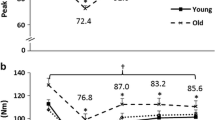Abstract
Changes in strength, speed and size of the quadriceps muscle have been investigated in elderly men and women after 6 months of isometric strength training. We have also indirectly investigated the role of metabolites as a stimulus for muscle hypertrophy by studying two training protocols. One thigh was trained using short, intermittent contractions (IC), while the other trained using long, continuous contractions (CC). This meant that there should be a greater metabolite change in the muscle performing CC, as the blood flow is occluded for longer. Nine subjects [eight women, mean (SE) age, 71.8 (2.9) years] were measured for contractile properties and strength before and after training, and compared to nine age-matched controls [71.5 (2.1) years]. The training group increased quadriceps strength by 48.7 (9.1)% (P < 0.005) and 53.1 (11.3) % (P < 0.005) following the IC and CC protocols, respectively. There was no change in muscle strength in the controls. Both muscles showed significant slowing after training as measured by the relaxation times and the force-frequency ratio. There were non-significant decreases in muscle fatigability after training. The control group also showed some significant decreases in fatigability and muscle speed. The training group showed significant increases in muscle (and bone) cross-sectional area of 4.0 (1.7)% and 4.9 (1.3)% following the CC and IC protocols, respectively. These increases were significantly different from the decrease observed in the control group. These findings suggest that people over the age of 55 still have the capacity to increase muscle strength and size, and that the training causes slowing of the muscle. Muscle hypertrophy does not seem to be strongly influenced by metabolite changes in this age group, as there were no differences in measurements observed between protocols.
Similar content being viewed by others
References
Brooks S, Faulkner J (1994) Skeletal muscle weakness in old age: underlying mechanisms. Med Sci Sport Exerc 26:432–439
Brown A, McCartney N, Sale D (1990) Positive adaptations to weight-lifting training in the elderly. J Appl Physiol 69: 1725–1733
Burke RE, Levine DN, Tsairis P, Zajac FE (1973) Physiological types and histochemical profiles in motor units of the cat gastrocnemius. J Physiol (Lond) 234:723–748
Carey Smith R, Rutherford OM (1994) A comparison of eccentric and concentric conractions in strength training in humans. J Physical (Lond) 475:26P
Edwards RHT, Grindrod S, Narici M, Rutherford OM, Sargeant AJ (1984) Assessment of human leg muscle size by anthropometry and X-ray computerized tomography. J Physiol (Lond) 353:4P
Edwards RHT, Hill DK, McDonnell M (1990) Myothermal and intramuscular pressure measurements during isometric contractions of the human quadriceps muscle. Am J Physiol 259:89–95
Frontera WR, Meredith CN, O'Reilly KP, Knuttgen HG, Evans WJ (1988) Strength conditioning in older men:skeletal muscle hypertrophy and improved function. J Appl Physiol 64:1038–1044
Henriksson J (1992) Effects of physical training on the metabolism of skeletal muscle. Diabetes Care 15 [Suppl 4]:1701–1711
Holloszy JO, Chen M, Cartee GD, Young YC (1991) Skeletal muscle atrophy in old rats: differential changes in the three fibre types. Mech Ageing Dev 60:199–213
Ikai M, Fukanaga T (1970) A study on training effect on strength per unit cross-sectional area of muscle by means of ultrasonic measurement. Int Z Angew Physiol Einschl Arbeitsphysiol 28:173–180
Jones DA, Rutherford OM (1987) Human muscle strength training: the effects of three different regimes and the nature of the resultant changes. J Physiol (Lond) 391:1–11
Jones PRM, Pearson J (1969) Anthropometric determination of leg fat and muscle plus bone volumes in young male and female adults. J Physiol (Lond) 204:63P-66P
Klitgaard H, Ausoni S, Damiani E (1989) Sarcopasmic reticulum of human skeletal muscle: Age-related changes and effect of training. Acta Physiol Scand 137:23–31
Lexell J (1993) Ageing and human muscle: Observations from Sweden. Can J Appl Physiol 18:2–18
O'Connor MC, Carnell P, Manuel JA, Scott OM (1992) Contractile characteristics of human quadriceps femoris muscle in active elderly and young adults. J Physiol (Lond):82P
Rice CL, Cunningham DA, Paterson DH, Dickinson JR (1993) Strength training alters contractile proerties of the triceps brachii in men aged 65–78 years. Eur J Appl Physiol 66:275–280
Rutherford OM, Jones DA, Newham DJ (1986) Clinical and experimental application of the percutaneous twitch superimposition technique for the study of human muscle activation. J Neurol Neurosurg Psychiatry 49:1288–1291
Schott J, Rutherford OM (1994) Changes in fatigability and contractile properties of the human quadriceps following isometric strength training. J Physiol (Lond) 475:26P-27P
Schott J, McCully K, Rutherford OM (1995) The role of metabolites in strength training. II. Short versus long isometric contractions. Eur J Appl Physiol 71: 337–341
Vandervoort A, Hayes C (1989) Plantarflexor muscle function in young and elderly women. Eur J Appl Physiol 58:389–394
Young A, Stokes M, Round JM, Edwards RHT (1983) The effect of high-resistance training on the strength and cross-sectional area of the human quadriceps. Eur J Clin Inves 13:411–417
Author information
Authors and Affiliations
Rights and permissions
About this article
Cite this article
Welsh, L., Rutherford, O.M. Effects of isometric strength training on quadriceps muscle properties in over 55 year olds. Europ. J. Appl. Physiol. 72, 219–223 (1996). https://doi.org/10.1007/BF00838642
Accepted:
Issue Date:
DOI: https://doi.org/10.1007/BF00838642




